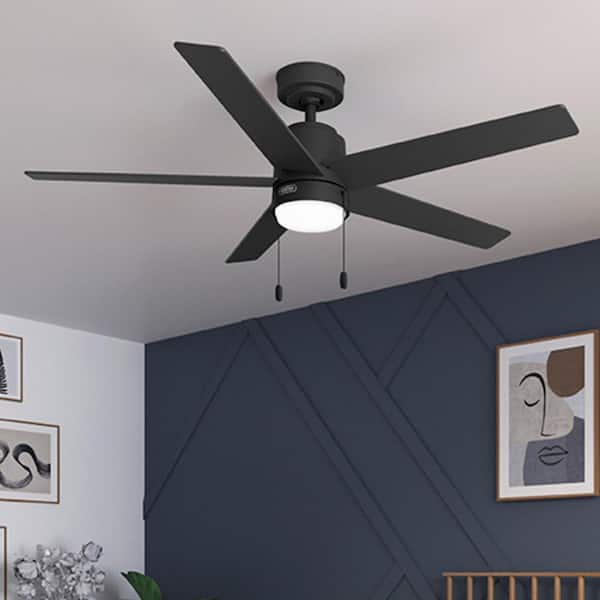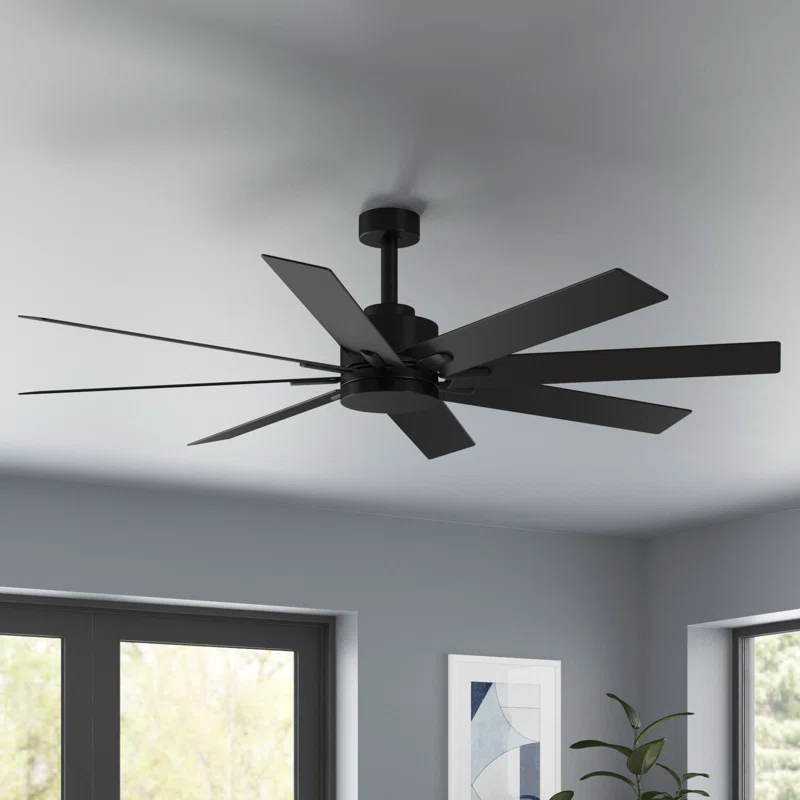
Ceiling Fan Installation: Common Mistakes to Avoid in Your Northern Virginia Home
Published: February 8, 2023 | Updated:
A ceiling fan can be a great addition to any room in your Northern Virginia home, improving air circulation, enhancing comfort, and even helping to reduce energy costs. While installing a ceiling fan might seem like a straightforward DIY project, several common mistakes can lead to wobbly fans, inefficient operation, or even serious electrical hazards. Homeowners in areas like Vienna (see our Vienna ceiling fan services) or Reston often ask us for help after a DIY attempt.
AJ Long Electric wants to ensure your ceiling fan installation is safe and effective. Here are common mistakes to avoid and professional tips for success.
Common Ceiling Fan Installation Mistakes
Mistake #1: Using the Wrong Electrical Box
One of the most dangerous and common mistakes we see throughout Northern Virginia homes is mounting a ceiling fan to a standard electrical box. Standard junction boxes are designed for light fixtures, not the weight and movement of ceiling fans.
Why it's a problem: Ceiling fans can weigh 25-50 pounds and create significant vibration when operating. A standard electrical box can loosen over time, potentially causing the fan to fall and create a serious safety hazard.
Pro Tip:
Always use a UL-listed ceiling fan-rated mounting box. These are specifically designed to support the weight and movement of ceiling fans. For retrofit installations in Arlington or Alexandria homes, special fan-rated boxes that brace between ceiling joists are available.
Mistake #2: Insufficient Mounting Support
Installing a ceiling fan without proper structural support is a common error we encounter in older Northern Virginia homes, particularly in Old Town Alexandria historical properties.
Why it's a problem: Even with a fan-rated box, if the mounting structure isn't secured properly to the building frame, the fan could still fall, causing damage and potential injury.
Pro Tip:
Ensure your ceiling fan is properly anchored to structural supports such as ceiling joists or fan-rated ceiling braces. For installations between joists, use a ceiling fan mounting bracket that spans between and secures to the joists.

A properly installed ceiling fan requires the correct mounting box and secure attachment to structural supports.
Mistake #3: Improper Wiring Connections
Incorrect wiring is both dangerous and a common cause of ceiling fan malfunctions in DIY installations across Fairfax County and beyond.
Why it's a problem: Improper wiring can cause electrical shorts, fire hazards, or prevent proper function of the fan and light kit. This issue is particularly common in homes with older wiring in places like Falls Church or McLean.
Pro Tip:
Always follow manufacturer's wiring instructions precisely. Standard connections include:
- Green or bare copper wire to the ground wire
- Black (hot) fan wire to the black house wire
- White (neutral) fan wire to the white house wire
- Blue wire (if present) connects to the switch leg for separate light control
Always secure wire connections with proper wire nuts and ensure no bare wires are exposed. If you're uncertain about your home's wiring, particularly in older Northern Virginia homes, consult a licensed electrician.
Mistake #4: Installing the Wrong Size Fan for the Room
Many Northern Virginia homeowners choose fans that are either too small or too large for their space, particularly in transitional and modern homes in areas like Ashburn or Tysons.
Why it's a problem: A fan that's too small won't move enough air to be effective. One that's too large can create uncomfortable downdrafts and may be visually overwhelming in the space.
Pro Tip: Ceiling Fan Sizing Guide
- Small rooms (up to 75 sq ft): 29-36 inch fan
- Medium rooms (76-144 sq ft): 42-48 inch fan
- Large rooms (145-225 sq ft): 52-56 inch fan
- Great rooms (225+ sq ft): 60+ inch fan or multiple fans
Mistake #5: Not Considering Ceiling Height and Clearances
Installing ceiling fans without proper clearances is a safety issue we frequently address in Northern Virginia, especially in homes with vaulted ceilings in Great Falls or McLean.
Why it's a problem: Fans installed too low can be hazardous if blades are within reach. Fans mounted too high or too close to the ceiling won't circulate air effectively.
Pro Tip: Ceiling Fan Height Guidelines
- Minimum 7 feet from the floor to the bottom of the fan blades
- Optimal height is 8-9 feet from the floor for most rooms
- 8-12 inches from the ceiling to the top of the fan for optimal airflow (more for vaulted ceilings)
- Minimum 18 inches from walls or sloped ceilings to the blade tips
- For ceilings over 9 feet, use a downrod to position the fan at the ideal height
Mistake #6: Failing to Balance the Fan Blades
Unbalanced ceiling fans are a common complaint we receive from homeowners throughout Fairfax County, Arlington, and Alexandria.
Why it's a problem: Unbalanced blades cause wobbling, which creates noise, reduces efficiency, and can damage the fan motor and mounting over time.
Pro Tip:
Most new fans come with a balancing kit. If yours didn't, or if it's an older fan that's become unbalanced, you can purchase a balancing kit separately. Follow the manufacturer's instructions to properly balance the blades. For stubborn cases, our ceiling fan service in Vienna and throughout Northern Virginia includes professional balancing.
Mistake #7: Not Using a Fan-Specific Wall Control
Using standard dimmer switches with ceiling fans is a dangerous mistake we occasionally encounter in Northern Virginia, especially in DIY renovations.
Why it's a problem: Standard dimmer switches are designed for lighting, not motor control. Using them with ceiling fans can damage the fan motor and potentially create a fire hazard. This is especially important when integrating with smart home systems in Arlington and other tech-forward Northern Virginia communities.
Pro Tip:
Always use controls specifically designed for ceiling fans. These include:
- Dedicated fan speed controls (not light dimmers)
- Combination fan/light wall controls
- Pull chains (included with most fans)
- Remote controls (popular in bedrooms and high-ceiling rooms)
- Smart fan controls (for integration with home automation systems)
Additional Ceiling Fan Installation Considerations for Northern Virginia Homes
Dealing with Older Homes and Insufficient Wiring
Many homes in established Northern Virginia neighborhoods like Old Town Alexandria, Georgetown, or Falls Church have older electrical systems that present unique challenges:
- No Neutral Wire: Older switch boxes may lack a neutral wire, which is required for many modern fan controls. Our electricians can update your wiring to accommodate modern fan installations.
- Inadequate Circuit Capacity: Older homes may have circuits that are already near capacity. Adding ceiling fans might require electrical panel upgrades or circuit modifications.
- Original Plaster Ceilings: Historic homes with plaster ceilings require special techniques to install fan mounting boxes without damaging the ceiling.
Outdoor and Damp Location Installations
For Northern Virginia's varied climate with humid summers and occasional harsh winters:
- Always use fans rated for damp or wet locations on covered porches, patios, or areas exposed to humidity
- Look for marine-grade finishes for fans near coastal areas or saltwater pools
- Ensure outdoor installations use proper weatherproof electrical boxes and connections
- Consider seasonal maintenance for outdoor fans to maintain performance and extend lifespan
Fan Efficiency and Energy Savings
For energy-conscious Northern Virginia residents:
- Look for ENERGY STAR rated ceiling fans, which move air up to 20% more efficiently than standard models
- Remember to adjust your thermostat when using ceiling fans (up in summer, down in winter) to maximize energy savings
- DC motor fans use up to 70% less energy than traditional AC motor fans and operate more quietly
- Proper fan direction is key: counterclockwise in summer for cooling, clockwise in winter to redistribute warm air
Professional Installation vs. DIY: Making the Right Choice
While some homeowners may have the skills to install a ceiling fan, many of the mistakes outlined above can be avoided by hiring a professional electrician. Consider professional installation if:
- You're replacing a light fixture with a ceiling fan (which requires a fan-rated box)
- You're installing a fan where no fixture currently exists
- Your home has old or non-standard wiring
- You want to add a dedicated circuit for the fan
- You're installing multiple fans or need complex controls
- You're uncomfortable working with electricity (always the safest choice)
What to Expect with Professional Ceiling Fan Installation
When you choose AJ Long Electric for your ceiling fan installation in Fairfax, Vienna, or anywhere in Northern Virginia, you can expect:
- Thorough assessment of your ceiling structure and electrical wiring
- Installation of appropriate fan-rated mounting box and support
- Proper electrical connections with attention to safety
- Professional assembly and mounting of the fan
- Installation of appropriate controls as desired
- Fan balancing and testing to ensure quiet, wobble-free operation
- Clean worksite with all packaging and debris removed
- Guidance on proper fan operation and maintenance
Ready for a Properly Installed Ceiling Fan in Your Northern Virginia Home?
A well-installed ceiling fan enhances comfort, improves energy efficiency, and can be an attractive design element in your Northern Virginia home. By avoiding the common mistakes outlined in this guide, you'll ensure your fan operates safely, quietly, and efficiently for years to come.
If you're ready to add ceiling fans to your home or need help with an existing installation, the expert electricians at AJ Long Electric bring years of experience installing ceiling fans throughout Fairfax County, Arlington, Alexandria, and all Northern Virginia.
Contact Us for Professional Ceiling Fan Installation!
Or call us at 703-997-0026